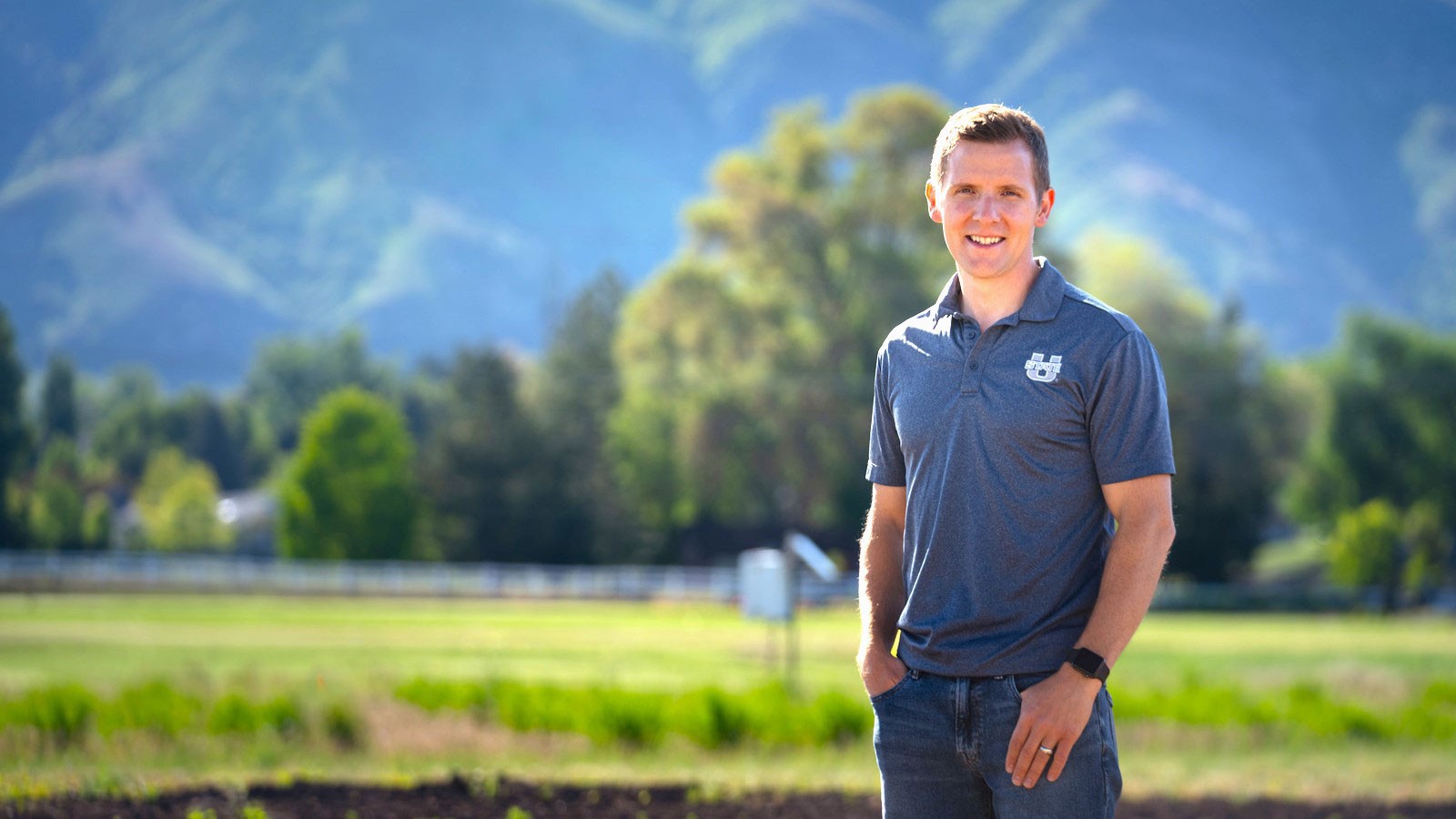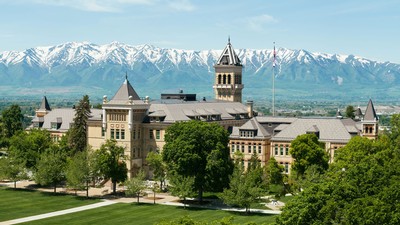USU Plant and Agroclimate Scientist Elected to Leadership in American Society of Agronomy
By Kinsey Bitterman |
Plant and agroclimate scientist Matt Yost helps Utah farmers improve production and optimize water use, and now serves colleagues in the American Society of Agronomy. (Photo by Bronson Teichert)
Matt Yost, a Utah State University associate professor of plant science and Extension agroclimate specialist, works to help farmers adjust to changing conditions and conserve water and was recently elected to serve on the American Society of Agronomy board.
Growing up on a dairy farm in Idaho, he was involved in agriculture, but it wasn’t until college that Yost decided to pursue his passion for plant science. He earned a bachelor's degree in agribusiness, science and technology and then further pursued a master's degree and a doctorate in applied plant sciences.
Yost’s education led him to work in Missouri for a few years and he has now been at USU for seven years where he serves the agriculture industry, specifically in Utah, as growers deal with the impacts of climate and drought and use methods that optimize how they use the water that is available. He also studies practices that build resiliency for farms, including helping farmers improve soil health and manage fertilizer and other nutrients.
His passion for applied plant science is acquired every day.
“I love helping farmers improve their production,” Yost said. “I love helping them try to be good stewards of the land, take care of their soil, produce good crops and healthy, nutritious food, so we all have food to eat.”
Yost primarily works with farmers but is in touch with state agencies and other organizations daily.
“I try to help farmers and ranchers in Utah, and the greater West, deal with the impacts of climate. That is where I spend a lot of my time,” Yost said, noting that drought and water scarcity are Utah’s number one issues as the population grows.
With research, Yost tries to implement or improve a couple of different factors when considering drought and water scarcity. He focuses on managing different irrigation systems and different crops to grow that could help reduce water use. While examining crops, he can dive deeper into how farmers manage them by studying things like plant genetics, tillage, and crop rotation with hopes of creating more resilience against drought. He also looks at soil health and how he can encourage reducing tillage, adding cover crops, and even introducing livestock. Healthy soil should be more resilient to stressors like drought, which in the end, should help farmers through tough climate changes when water is scarce.
Currently, Yost is working on a couple of different water optimization projects. There are small projects scattered throughout the state but one of the major ones he is working on involves helping farmers in the Colorado River Basin. To do so, Yost and Assistant Professor of Civil and Environmental Engineering and USU Extension Irrigation Specialist Burdette Barker, created the Agricultural Demonstration Research Implementation Program (AG-DRIP) about a year and a half ago.
AG-DRIP is funded by the Colorado River Authority of Utah and the Central Utah Water Conservancy District with intentions to build resiliency by measuring and managing irrigation on farms in the Colorado River Basin over the next three and a half years. Focusing on these larger issues is what Yost finds the most rewarding.
“I really enjoy most of what I do, and I do a lot of different projects,” Yost said, and added specifically about AG-DRIP: “I’m excited about what we are doing there… being able to help this many producers over a large area to plan and improve their irrigation management has been really rewarding so far and I think it will continue to grow in its impacts and its value.”
Yost was recently elected to the board of the American Society of Agronomy (ASA) as the Agronomic Production System Section Representative. This is the largest section in the ASA. The ASA is a growing global scientific and professional society that develops, distributes and utilizes agronomic solutions to feed and sustain the world. The society is split into five different sections, and each section has its own board representative.
USU Plants, Soils and Climate Department Head Paul Johnson said Yost’s new position on the ASA board is a very important leadership role and that he has an opportunity to direct the society’s future and the future of crop science.
Yost has been involved with the ASA for 17 years. He started serving the organization during his undergraduate studies and has been actively involved since. His new role requires a 3-year term in which Yost will represent the section and take part in governing the society, planning annual meetings, setting the strategic mission, reviewing and updating the society bylaws, and other duties.
“I’m excited for the new opportunity. … Mostly what I have done in the past has been with smaller community sections, so I’m excited to sit around the table and help make decisions that help impact the whole society,” Yost said.
WRITER
Kinsey Bitterman
kinsey.bitterman@usu.edu
CONTACT
Matt Yost
Specialist/Assistant Professor
Extension/Plants, Soils and Climate Department
matt.yost@usu.edu
TOPICS
Faculty 321stories Water 266stories Agriculture 228stories Farming 79storiesComments and questions regarding this article may be directed to the contact person listed on this page.







